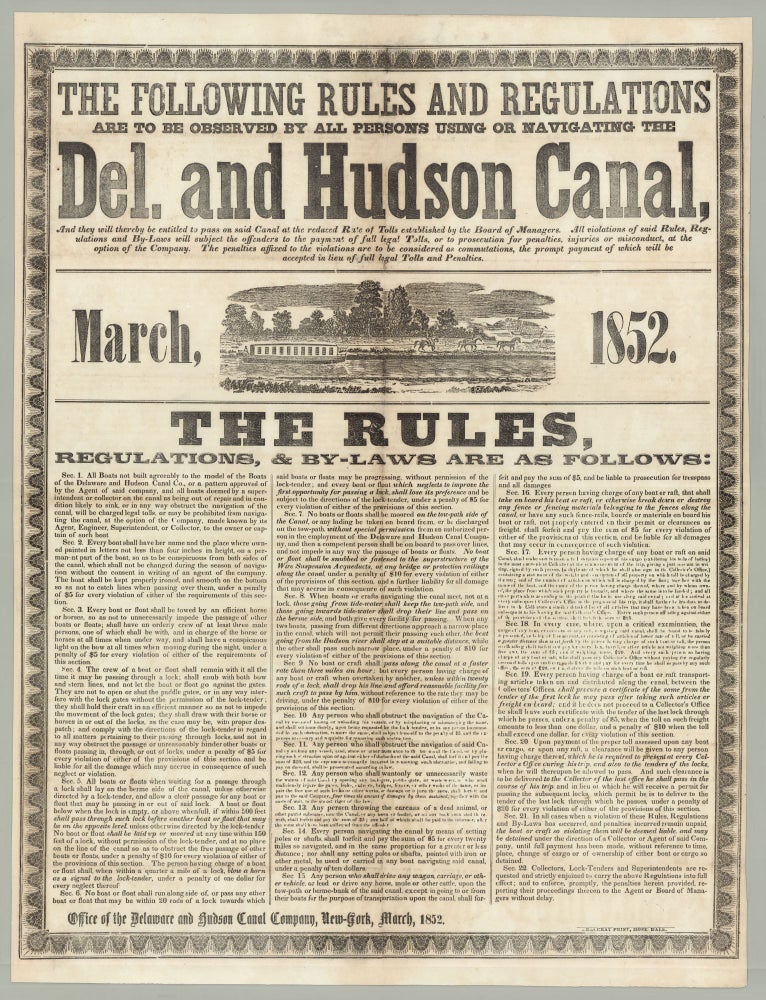The Following Rules and Regulations are to be observed by all persons using or navigating the Del. and Hudson Canal and they will be entitled to pass on said Canal at the reduced rate of Tolls established by the board of managers. All violations of said rules, regulations and by-laws will subject the offender to the payment of full legal tolls, or to prosecution for penalties, injuries or misconduct, at the option of the Company. The penalties affixed to the violations are to be considered as commutations, the prompt payment of which will be accepted in lieu of full legal tolls and penalties.
Honesdale, Pennsylvania: Office of the Delaware and Hudson Canal Co., New York; Democrat Print, Honesdale [PA], March 1852. Illustrated broadside, 22.5” x 17.5” plus margins, wood-engraving, 2.75” x 8.25”, with text in columns below, the whole set within ornamental border. CONDITION: Very good, old folds, a few letters partially effaced but no loss of sense. A fascinating unrecorded broadside for the Delaware and Hudson Canal listing its twenty-two rules, regulations and by-laws, illustrated with a wood-engraving of a canal boat being towed by a team of horses. Built between 1825 and 1829, the 108 mile-long Delaware and Hudson Canal was built to transport anthracite coal from Pennsylvania mines to markets on the Hudson River. In the nineteenth century the Delaware and Hudson Canal, together with the Pennsylvania Coal Company railroad, expanded to become part of a 171-mile transportation system. In the second half of the nineteenth century, however, railroads grew while canals declined (transportation via canal was limited by winter weather conditions, droughts, and floods), railroads proving better able to reach new markets. In 1898 the Delaware and Hudson Canal was abandoned. Boats failing to abide by the broadside’s twenty-two rules were subject to penalties, while those that followed them were eligible to pay tolls at a reduced rate. The first nine rules relate to boats: 1) All boats shall be up to the standards of the Delaware and Hudson Canal Co.’s model of boats or a model approved by a company Agent; 2) Boats shall have their name and place on a permanent part of the vessel; 3) Boats shall be towed by efficient horses; 4) The boat’s crew shall remain with it the entire time it is passing through a lock; 5) Boats when waiting for passage through a lock shall lay on the berme side of the canal and allow other boats to pass through the lock; 6) Boats are forbidden from running alongside of, or passing, any boat within twenty rods of a lock towards which the boats are moving; 7) No boats shall be moored on the tow-path side of the canal without special permission; 8) When boats meet, not at a lock, those going from tide-water shall keep the tow-path side, and those going towards tide-water shall drop their line and pass on the berme side; 9) No boats shall be driven faster than three miles an hour. The final thirteen rules relate to persons in charge of boats as well as employees of the company: 10) No person may obstruct the canal by means of loading or unloading their vessel; 11) No person may obstruct the canal by sinking any vessel, coal, stone, or otherwise; 12) No person may wantonly or unnecessarily waste the canal’s waters by opening any lock-gate, paddle-gate, or waste-weirs; 13) No person may throw carcasses of dead animals or other putrid substances into the canal; 14) Persons navigating the canal by means of setting poles or shafts will pay $5 for every twenty miles so navigated; 15) Persons who drive vehicles or animals on the tow-path or berme-bank of the canal shall pay $5; 16) Persons that destroy the fence along the canal will pay $5; 17) Persons shall make and furnish a full detailed report of their cargo to a Collector at the start of their trip; 18) Persons who furnish false representations of cargo, or the distance they traveled, shall owe $5 or more; 19) Persons transporting articles shall procure a certificate from the tender of the first lock they pass; 20) Persons are to present proof of having paid tolls at every Collector’s Office and tender of a lock; 21) When rules, regulations, or by-laws have been violated and penalties incurred remain unpaid by the owner, the owner’s boat may be detained by the company until full payment is made; 22) Collectors, lock-tenders, and superintendents are to carry into effect and enforce the penalties stipulated on this broadside, and report them to the company’s Agent or Board of Managers. No copies recorded in OCLC. An appealing broadside providing a systematic overview of the operations of the Delaware and Hudson Canal. REFERENCES: “D&H Canal” at National Park Service online.
Item #7927
Price: $2,500.00


